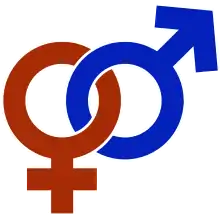Gender sensitization
Gender sensitization presides over gender sensitivity, the modification of behavior by raising awareness of gender equality concerns.[1] This can be achieved by conducting various sensitization campaigns, training centres, workshop, programs etc. Sensitization in the domain of Humanities and Social Sciences, is seen as an awareness informed propensity or disposition which aims at changing behavior so that it is sensitive to certain issues. Gender sensitization may be seen as "the awareness informed propensity to behave in a manner which is sensitive to gender justice and gender equality issues."[1]

It is interlinked with gender empowerment.[2] Gender sensitization theories claim that modification of the behavior of teachers and parents (etc.) towards children which can have a causal effect on gender equality[3].
Gender sensitizing "is about changing behavior and instilling empathy into the views that we hold about our own and the other genders."[4] It helps people in "examining their personal attitudes and beliefs and questioning the 'realities' they thought they know.
References
- Dr. Jatinder Kumar Sharma (March 2016). "Understanding the Concept of Sensitisation in Humanities and Social Sciences: An Exploration in Philosophy of Mind". International Journal of Scientific Research. 24 (90): 380–400.
- Bhowmick Soma. "Gender Sensitization and Police". Retrieved 17 February 2014.
- Pandey, Ashutosh (2018-07-16). "Gender Sensitization: Problems and Strategies". Isaconf. Cite journal requires
|journal=(help) - Aksornkool, Namtip. Joerger, Cindy; Taylor, Elaine (eds.). Gender sensitivity: a training manual for sensitizing education managers, curriculum and material developers and media professionals to gender concerns. p. VIII.